Comparing Fiber Optic Cleaners
- Feb 6th 2025

Although fiber optic systems are the foundation that underpins all digital communications and make up the backbone of how the world connects, contamination of fiber optic connector end faces remains a primary cause of network failures.
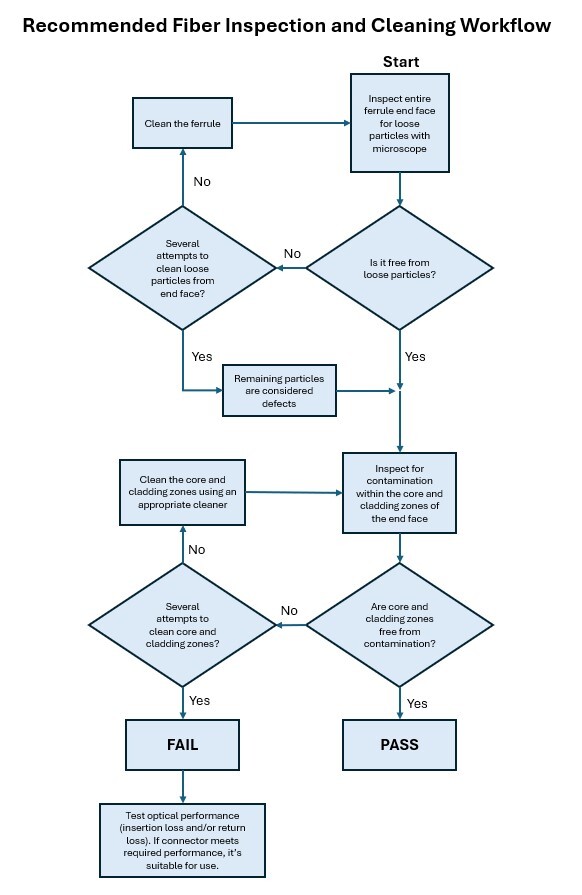 Dust and oil on a fiber end face can block light signals, causing loss and reflections that degrade network performance or cause costly downtime. When mating fiber optic connectors, a dirty end face can also contaminate a clean one—including those on expensive network transceiver ports.
Dust and oil on a fiber end face can block light signals, causing loss and reflections that degrade network performance or cause costly downtime. When mating fiber optic connectors, a dirty end face can also contaminate a clean one—including those on expensive network transceiver ports.
How To Clean Fiber Optics
The recommended process for cleaning a fiber end face is first to inspect the end face. There’s no need to clean the fiber end face if it’s already clean, especially since cleaning a connector when unnecessary can actually attract dust due to static electricity.
The IEC 61300-3-35 standard covers visual inspection of fiber optic connectors and fiber-stub transceivers and includes cleanliness acceptance criteria. The latest version (edition 3) recommends specific workflow steps for inspection and cleaning. The workflow starts by inspecting the entire ferrule end face for loose particles using a microscope and cleaning if necessary. This can help prevent debris on the ferrule from ending up on the end face.
The next step is to inspect the critical zones of the end face where light signals transmit (fiber core and cladding) and clean the end face if necessary. The IEC standard recommends using an intelligent inspection tool with automated PASS/FAIL analysis capability based on acceptance criteria for inspecting the fiber core and cladding. It’s important to note that the latest version of the IEC 61300-3-35 standard also recognizes that the optical performance of a connector takes precedence. Therefore, if a connector end face fails inspection even after cleaning but it meets insertion loss and return loss requirements when testing, it is considered suitable for use.
When inspection reveals the need to clean the fiber, cleaning can be done using a wet or dry process, or a combination thereof. Wet cleaning involves the use of cleaning fluids, while dry cleaning uses only dry wipes and cleaners without fluids. While optical-grade wipes and cleaners are designed to be lint-free and dissipate static without scratching the end face, best practice is typically to use a combination of both wet and dry cleaning, referred to as a wet-dry or wet-to-dry process. Even with static-dissipating wipes, dry cleaning alone can create a static charge that attracts dust, especially in low-humidity environments.
Wet-dry cleaning involves using cleaning fluid that helps prevent static charge and makes it easier to remove contaminants. It’s important to note that only optical-grade cleaning fluids should be used. Never use over-the-counter cleaners such as isopropyl alcohol (IPA) to clean fiber end faces. IPA is ineffective at removing common contaminants like gels and oils and can leave behind residue.
One of the keys to preventing fiber end-face contamination in the first place is to ensure cabinets, enclosures, and other fiber workspaces are free of dust and debris. Aerosol dust removers that use dry gas are ideal for preparing a dust-free working environment. Before working with fiber, wash your hands and avoid using any moisturizer. Clean hands are less likely to transfer oils to any fiber end faces. It’s also essential to clean your microscopes and inspection equipment with general-purpose optical wipes to avoid transferring any contamination to the fiber end faces during inspection.
When it’s time to clean the fiber end face, using the right type of fiber optic cleaner is also essential.
Types of Fiber Optic Cleaners
Different types of fiber optic cleaners and consumables are available for various applications.
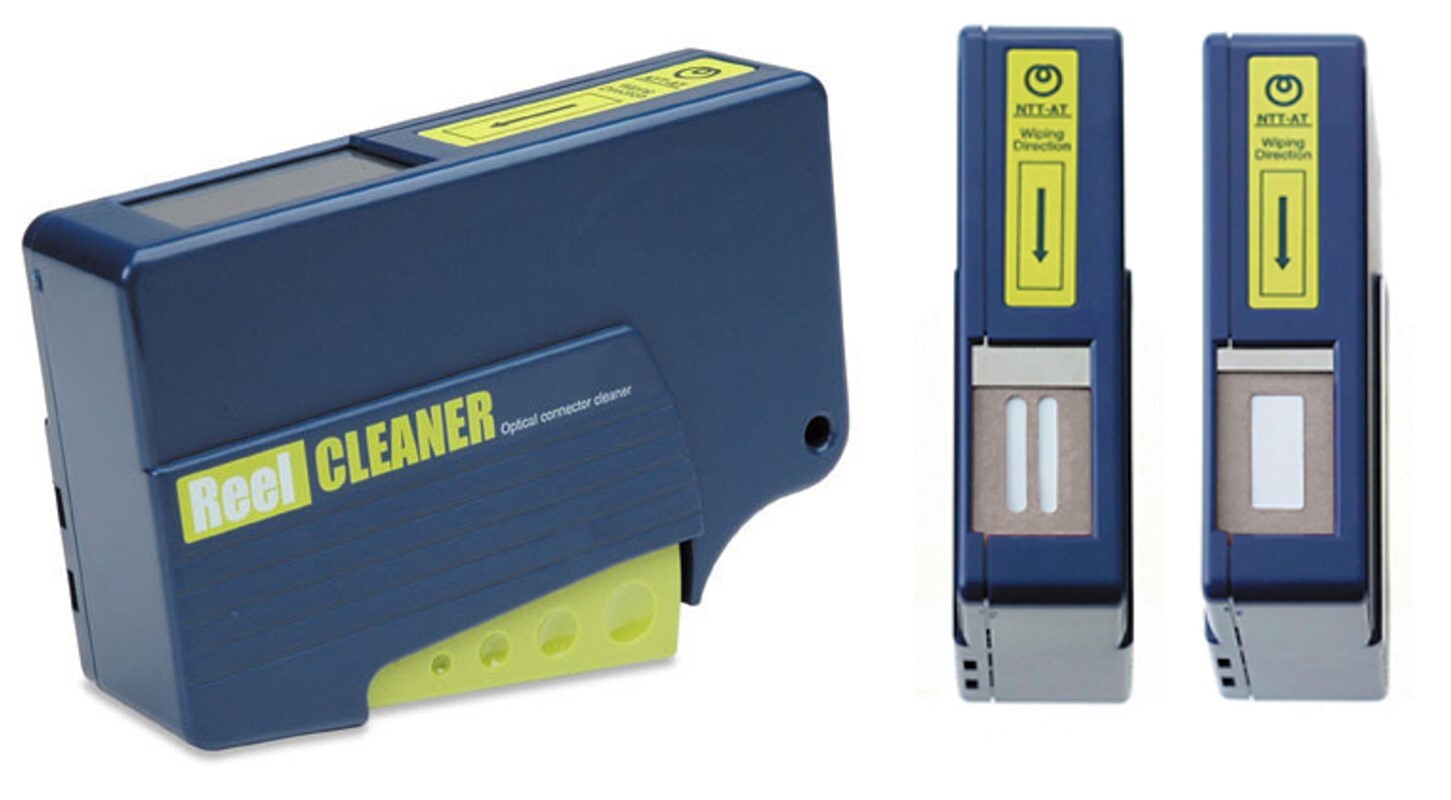 Fiber optic cassettes are a quick and easy way to clean fiber optic connectors on fiber jumpers and cabling assemblies. Cassettes are refillable dispensers with a slot that dispenses a clean section of dry cloth with each use. They can be used for dry cleaning by simply dragging the connector across the exposed, clean dry material. They can also be used for wet-dry cleaning by adding optical fluid to one area of the exposed cloth and dragging the connector from the wet to the dry area. Cassettes are available with different slots to accommodate various connectors. For example, a cassette may have two slots for cleaning duplex connectors, or it may be designed to accept guide pins for cleaning male MTP/MPO connectors.
Fiber optic cassettes are a quick and easy way to clean fiber optic connectors on fiber jumpers and cabling assemblies. Cassettes are refillable dispensers with a slot that dispenses a clean section of dry cloth with each use. They can be used for dry cleaning by simply dragging the connector across the exposed, clean dry material. They can also be used for wet-dry cleaning by adding optical fluid to one area of the exposed cloth and dragging the connector from the wet to the dry area. Cassettes are available with different slots to accommodate various connectors. For example, a cassette may have two slots for cleaning duplex connectors, or it may be designed to accept guide pins for cleaning male MTP/MPO connectors.
Stick-style cleaners are fiber cleaners that offer more precise cleaning for different connector types. They are ideal for cleaning connectors in bulkhead adapters in tight spaces, such as those at patch panels or transceivers. Stick-style cleaners use a dry cleaning process but can accommodate wet cleaning using optical cleaning fluid. Stick cleaners are available as inexpensive disposable swabs that are manually inserted into adapters and feature a fibrous cleaning tip that conforms to the end face. More advanced stick-style cleaners come with push-to-clean action that provides proper pressure without damaging the end face.
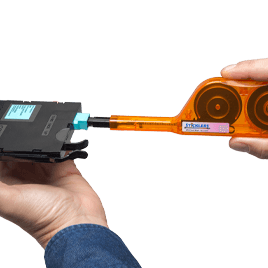
Stick-style cleaners come in assorted sizes to clean standard 2.5 mm connectors (e.g., SC, FC, and ST), 1.5 mm connectors (e.g., LC, CS, and MU), or specialty harsh-environment and mil-spec connectors. Stick-style cleaners are also available as multi-fiber connector fiber optic cleaners for use with MTP/MPO connectors or MMC connectors.
Another type of fiber cleaner is an advanced touchless cleaner that delivers a micro-dose of atomized cleaning fluid in a narrow stream of pressurized air, making no physical cont
act with the end face to eliminate the potential for any scratching or pitting. Available with different size tips for cleaning multiple connector types, touchless cleaners are battery-powered and can clean thousands of connectors. While touchless cleaners are more expensive, they are ideal for high fiber-count environments like data centers and broadband FTTX applications.
Choosing a Fiber Optic Cleaner
When choosing a fiber optic cleaner, there are a few factors to consider. Primarily, you must choose a cleaner designed for the type and size of the connector you need to clean. You also need to consider the number of connectors, cleaning environment, and type of cleaning, as well as external factors like budget. 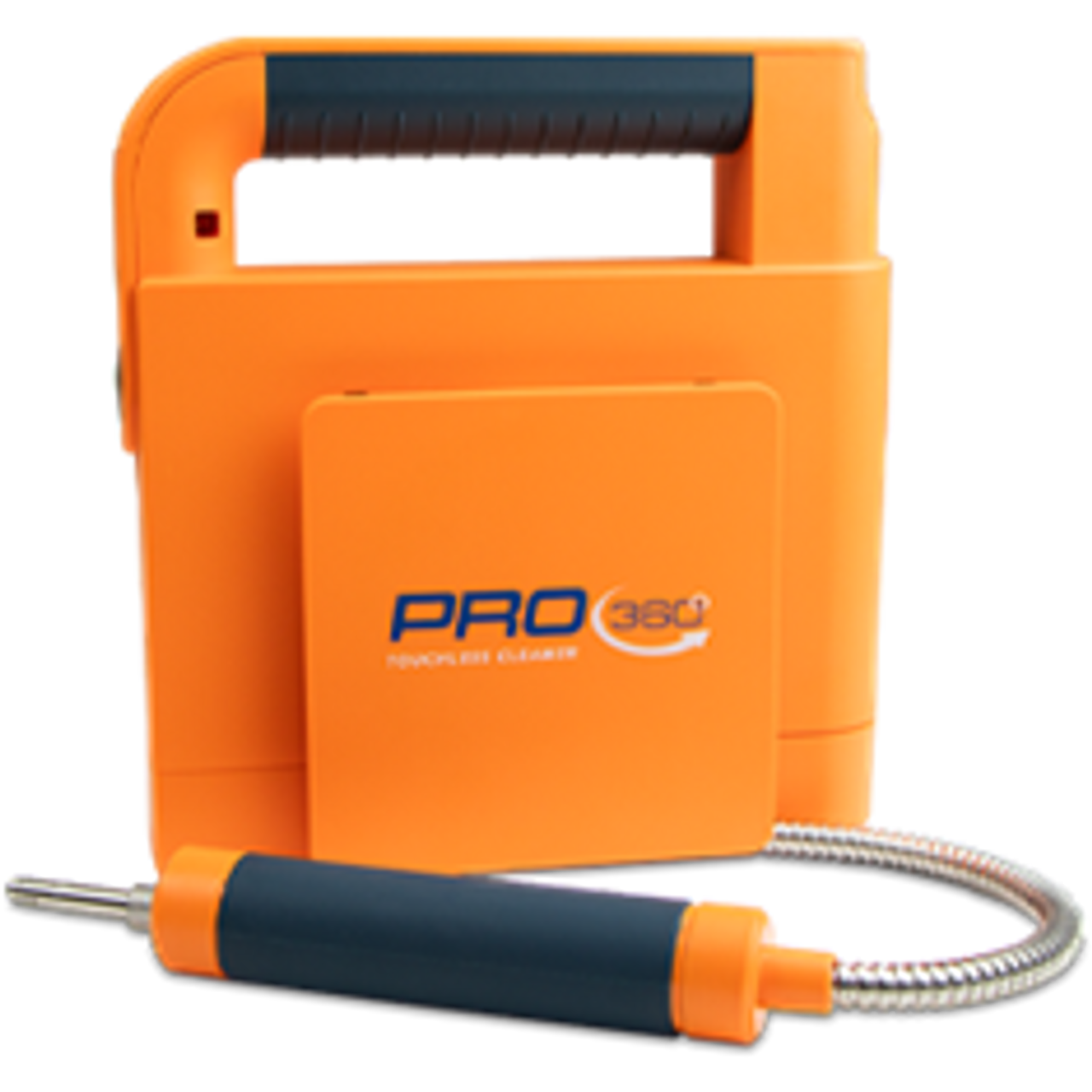 The following are the key considerations when choosing a fiber optic cleaner.
The following are the key considerations when choosing a fiber optic cleaner.
-
Type of Connector – Connectors on jumpers can be cleaned with cassettes and stick-style cleaners, while connectors in bulkhead adapters require a stick-style cleaner.
-
Size of Connector – Both cassettes and stick-style cleaners are connector-specific based on ferrule size and connector type. Some solutions are color-coded to help select the right cleaner.
-
Cleaning Environment – Cleaning fiber end faces in tight spaces is easier with hand-held stick-style cleaners, while advanced touchless cleaners are designed for bench-top use.
-
Cleaning Frequency – While disposable cleaning solutions are ideal for small jobs, cleaning sticks typically specify a number of cleanings in the 400 to 500 range and cassettes are refillable. For high volumes, advanced touchless cleaning solutions provide rapid, controlled, and repeatable cleaning.
-
Type of Cleaning – The recommended wet-dry cleaning process using either cassettes or stick-style cleaners requires cleaning fluid explicitly designed for fiber optics.
External Factors – Other considerations include budget, sustainability, and disposal. While disposable solutions may be cheaper, they inherently have more waste and disposal. Choosing longer-lasting and refillable solutions may ultimately be more cost-effective and greener.
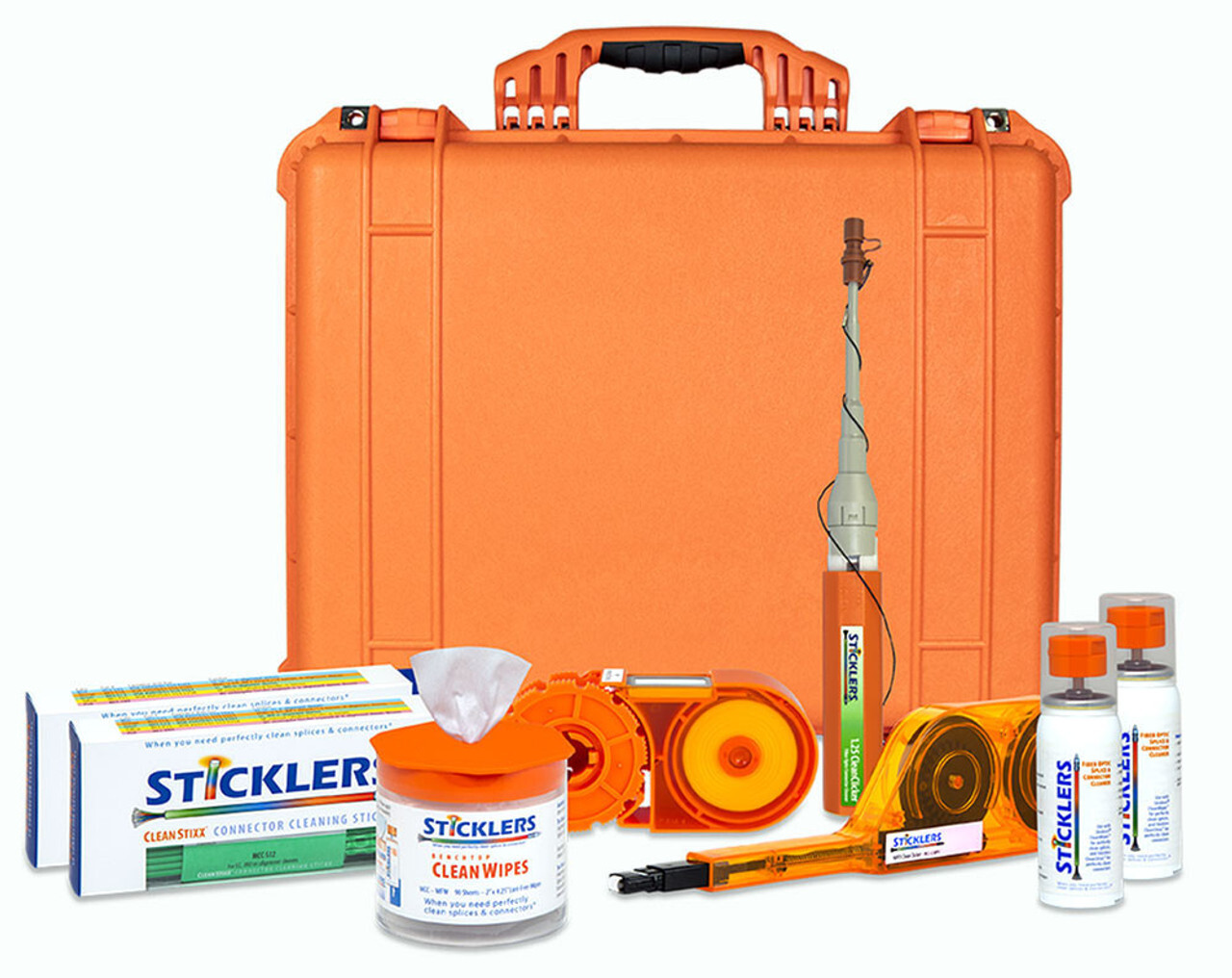 While there are distinct types of cleaners to choose from, technicians rarely require just one type. Most technicians work with multiple connector types and must clean connectors both on jumpers and within bulkhead adapters. Fiber optic cleaning kits are ideal because they offer multiple tools and consumables for a wide range of cleaning needs and volumes – all packed in a handy storage case for easy organization and portability in the field.
While there are distinct types of cleaners to choose from, technicians rarely require just one type. Most technicians work with multiple connector types and must clean connectors both on jumpers and within bulkhead adapters. Fiber optic cleaning kits are ideal because they offer multiple tools and consumables for a wide range of cleaning needs and volumes – all packed in a handy storage case for easy organization and portability in the field.
The good news is that CablesPlus is a premier supplier of all types of fiber optic cleaning products, from cassettes, stick-style, advanced touchless solutions, and kits to cleaning fluids, wipes, and refills. And our complete range means we’ve got a cleaner for all your connector types—1.5mm, 2.5mm, MPO, MMC, Opti-Tap, harsh environment, mil-spec, and more. Contact us today for all your fiber needs.
Explore Our Complete Range of Fiber Cleaners Contact an Expert
